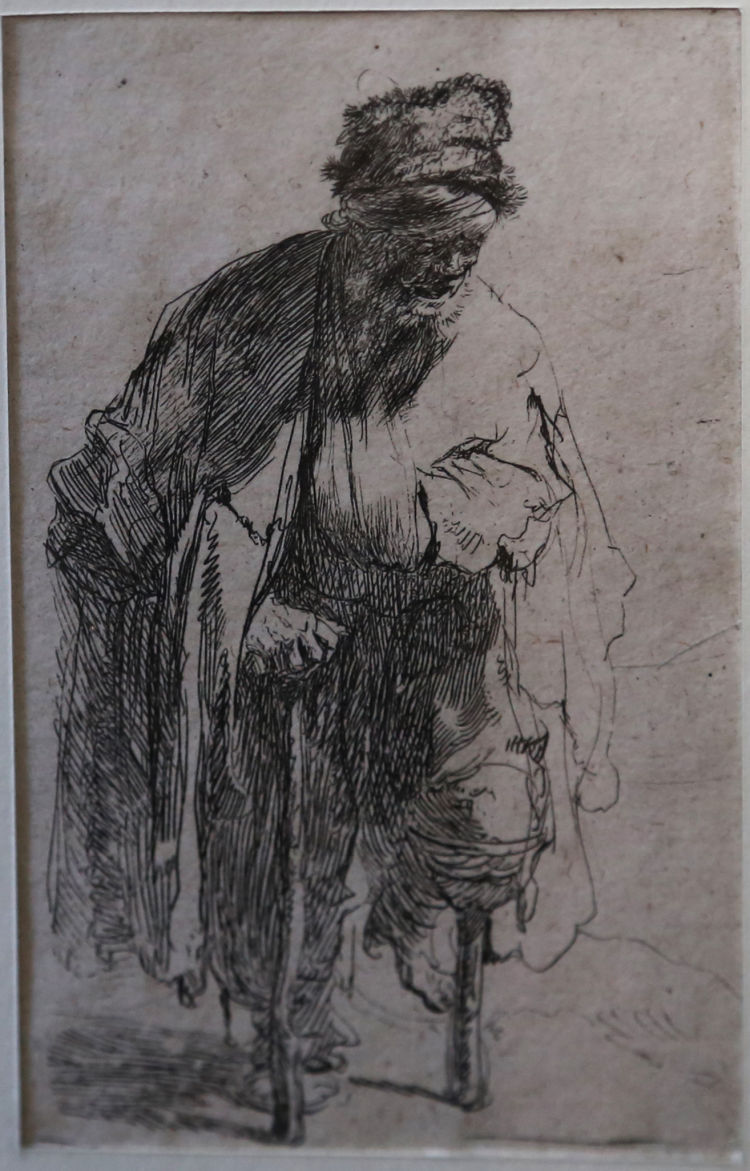



| Reference: | S39966 |
| Author | Harmensz van Rijn detto REMBRANDT |
| Year: | 1630 ca. |
| Measures: | 67 x 114 mm |


| Reference: | S39966 |
| Author | Harmensz van Rijn detto REMBRANDT |
| Year: | 1630 ca. |
| Measures: | 67 x 114 mm |
Good example, printed on contemporary laid paper, trimmed close to plate mark, in very good condition.
According to the titles generally used for Rembrandt’s etchings, 16 of them depict beggars.
This one reveals a middleaged man with a peg leg under his left knee . His left lower leg, however, is present and appears to be not abnormally short or otherwise deformed. It is flexed at the knee and hangs downward, with the foot not touching the ground. The foot itself is not covered by a shoe or sock and can be seen clearly. It is of normal shape and does not provide a clue as to the reason for the artificial leg. The right leg is present but cannot be seen in detail. His left hand is held in a sling and he has a stick in his right hand.
For the use of artificial legs supporting non-amputated limbs, cfr. J. J. ten Kate, F. G. I. Jennekens, J. M. E. Vos-Niël “Rembrandt’s ‘Beggar with a wooden leg’ and other comparable prints” http://citeseerx.ist.psu.edu/viewdoc/download?doi=10.1.1.876.8021&rep=rep1&type=pdf
They conclude that in the period 1500 – 1700 artificial legs were not only used in the case of absence of part of a lower limb, but also for other reasons, notably disorders of the knee, lower leg or foot. They may also have been used to attract compassion.
|
TIB, 50, p. 145 n. 179; White – Boon, p. 88. N. B179; Biörklund-Barnard, p. 32, n. BB30-4; Nowell-Usticke, n. B179; New Hollstein. (Rembrandt) I.72.49.i; Hollstein XVIII.88.179.II; Hind 46.12.II
|
Harmensz van Rijn detto REMBRANDT (Leida 1606 - Amsterdam 1669)
|
Born in Leiden, Holland in 1606, Rembrandt studied with Jacob Isaacsz van Swanenburgh (1571-1638) and Pieter Lastman (1583-1633). By 1626 he was an independent painter, working in Leiden alongside Jan Lievens (1607-74), another pupil of Lastman.
In 1631 Rembrandt moved to Amsterdam where he painted portraits of wealthy merchants. Three years later, he married his first wife, Saskia, and by the end of the 1630s he had moved into a substantial house (now the Rembrandt House Museum). In 1642, the year Rembrandt completed The Nightwatch (Rijksmuseum, Amsterdam), Saskia died.
By 1649, Hendrikje Stoffels had become his housekeeper and partner. Both Saskia and Hendrikje Stoffels posed for many paintings and sketches, often appearing as Susannah, Diana, Flora, Artemisa and other classical or Biblical figures. Rembrandt, however, was plagued by financial troubles and in 1656 his assets were made over to the courts, and many were sold. With his wife and son in financial control, Rembrandt continued to paint. Hendrikje died in 1663, his son Titus in 1668 and Rembrandt himself in 1669.
In his drawings, etchings and paintings, Rembrandt treated every subject: histories, landscapes, portraits, self-portraits, everyday scenes or sketches from nature. Rembrandt's biographer, Cornelis de Bie, praised his paintings, 'which enlighten every mind', and his etchings which are 'the very soul of life that lives therein'.
|
|
TIB, 50, p. 145 n. 179; White – Boon, p. 88. N. B179; Biörklund-Barnard, p. 32, n. BB30-4; Nowell-Usticke, n. B179; New Hollstein. (Rembrandt) I.72.49.i; Hollstein XVIII.88.179.II; Hind 46.12.II
|
Harmensz van Rijn detto REMBRANDT (Leida 1606 - Amsterdam 1669)
|
Born in Leiden, Holland in 1606, Rembrandt studied with Jacob Isaacsz van Swanenburgh (1571-1638) and Pieter Lastman (1583-1633). By 1626 he was an independent painter, working in Leiden alongside Jan Lievens (1607-74), another pupil of Lastman.
In 1631 Rembrandt moved to Amsterdam where he painted portraits of wealthy merchants. Three years later, he married his first wife, Saskia, and by the end of the 1630s he had moved into a substantial house (now the Rembrandt House Museum). In 1642, the year Rembrandt completed The Nightwatch (Rijksmuseum, Amsterdam), Saskia died.
By 1649, Hendrikje Stoffels had become his housekeeper and partner. Both Saskia and Hendrikje Stoffels posed for many paintings and sketches, often appearing as Susannah, Diana, Flora, Artemisa and other classical or Biblical figures. Rembrandt, however, was plagued by financial troubles and in 1656 his assets were made over to the courts, and many were sold. With his wife and son in financial control, Rembrandt continued to paint. Hendrikje died in 1663, his son Titus in 1668 and Rembrandt himself in 1669.
In his drawings, etchings and paintings, Rembrandt treated every subject: histories, landscapes, portraits, self-portraits, everyday scenes or sketches from nature. Rembrandt's biographer, Cornelis de Bie, praised his paintings, 'which enlighten every mind', and his etchings which are 'the very soul of life that lives therein'.
|